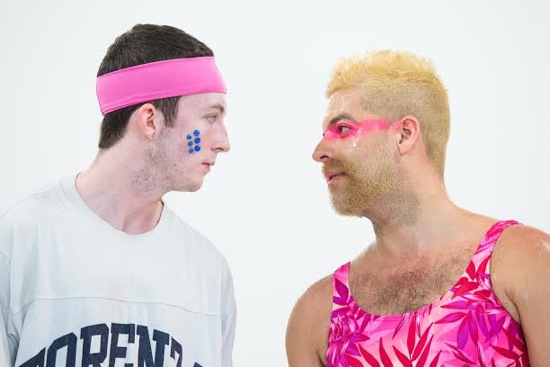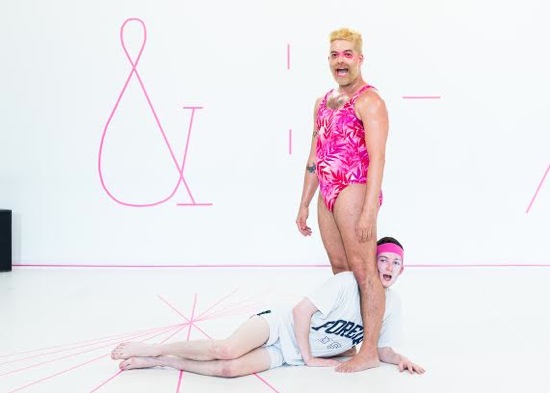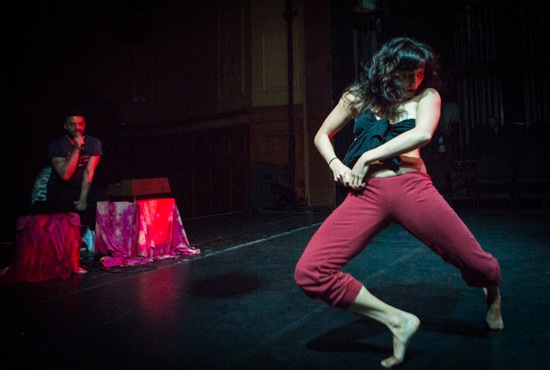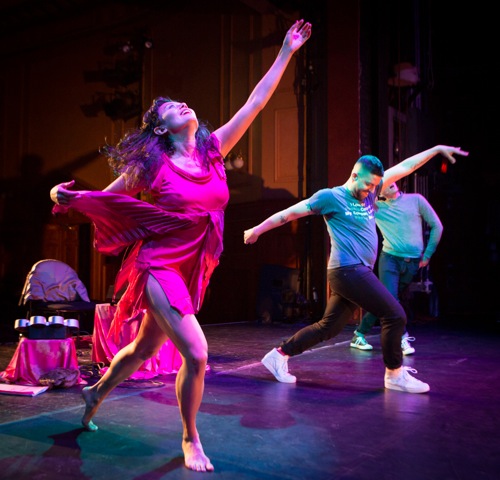Miguel Gutierrez’s Age & Beauty, Parts 1 and 2, presented during American Realness 2015.
I didn’t see Miguel Gutierrez’s Age & Beauty Part 1: Mid-Career Artist/Suicide Note or &:/ when it was first performed as part of the 2014 Whitney Biennial. Instead I saw it in Studio C of Gibney Dance’s Agnes Varis Performing Arts Center (the rescued and handsomely re-conceived former Dance New Amsterdam premises), as part of American Realness 2015, the week before Age & Beauty Part 2 premiered at the Abrons Art Center.
As a result, I’ve been thinking quite a lot about the differences between aging and being old. There’s no getting around “old” (although two 80-year-olds, say, may differ considerably in terms of what they can and can’t do and how they appear). Aging is an unavoidable ongoing process terminated by death. But people feel it to different degrees. You stop believing in Santa Claus, you develop body hair, you lose your virginity; you don’t call that aging, you call it growing up. Gutierrez is 42. If you’re 42 with a mate, a five-year-old kid, a reasonably satisfying career, and no debts, you may hardly notice that you’re aging, but Gutierrez—a gay male, unmarried as yet, struggling to finance and maintain a career as a choreographer and performer—is enduring a mid-life crisis. So I’d never be so thoughtless as to say to him, “42 isn’t old!”
He puts his pain out there for us to feel—eloquently and without self-pity—along with his joy, just as he explored his past and present ten years ago in his Retrospective Exhibition. As we enter the white-walled, white-floored Studio C, he and his partner in this duet, Mickey Mahar, are warming up, and Gutierrez is playing host as well, occasionally greeting people and offering little bottles of shocking pink nail polish for us to pass around and use. His own nails are that color, and some audience members paint a nail or two to show solidarity. He introduces the show in a friendly, thoughtful voice, mentioning Queer theorists along the way and quoting the last lines of a letter that poet William Blake wrote to his friend Thomas Butts: “I have a thousand and ten thousand things to say to you. My heart is full of futurity.”
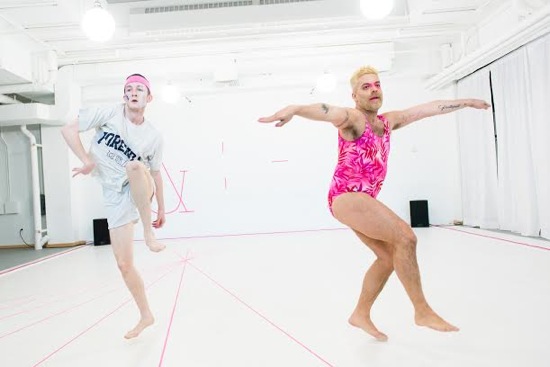
Mickey Mahar (L) and Miguel Gutierrez in Age & Beauty Part 1: Mid-Career Artists/Suicide Note or &:&/. Photo: Ian Douglas
I should perhaps have mentioned earlier that Gutierrez’s hair and beard have been bleached to pale yellow and that he is wearing a woman’s pink one-piece bathing suit with a pattern of deeper pink ferns. Smudgy pink lines surround one eye like half a pair of phantom spectacles. Mahar is as pale as Gutierrez is olive-skinned, as skinny as his colleague is fleshy. And 24-years- old. Mahar wears drab, loose-legged shorts, a baggy white tee shirt that says Forenza on it, and a pink headband. The implication is that he’s so young and beautiful that it doesn’t matter what he wears.
The electronic drums kick in and, side by side, the two men strut and vamp to house music (addition credit for dance material is given to Christoffer Schieche and Roman Van Houttven). No trying to seduce the audience, although Gutierrez takes us in and appears to enjoy himself. This is serious business. To see the two doing the same steps brings out the differences between them. Gutierrez is strong, compact in terms of the space he occupies. Mahar looks even younger than he is—supple, gangly, endearingly awkward despite his skill, all flyaway knees and elbows. Shortly, they break into counterpoint. The dancing is strenuous; the two work the runway strut into variations; they hump the floor. You can understand the need for rest breaks. During one long one, they stand hand in hand, and it takes a while to realize that they are taking a creakingly long time to turn toward each other and sink and twist until their mouths meet in a kiss.
I realize only afterward that Age and Beauty Part 1 is structured like a classical pas de deux. After this first duet, each takes a solo. Mahar—loose, springy, and sinuous bolts around the space, tries to climb a wall, pulls his pants down a bit, yanks his shirt over his head. He staggers, he rolls, he gambols (I suspect this is an improvisation). He exits. Now Gutierrez wrenches himself into action. He’d like to charm us. He balances quite a while on one leg, he does a headstand, he pulls his bathing suit up to reveal his buttocks. But he’s also reckless. Or dizzy. Or dazed. He jumps and turns in the air, crashes to the floor. He starts crawling on all fours, making raspberry noises. Shockingly, after Mahar re-enters and sits on him, Gutierrez sticks one hand in his partner’s mouth, grabs his head with the other, and pulls him around the room.
In one passage, the two speak in unison so immaculate it amounts to a tour de force. Two bodies, a single voice. The script begins: “We are the dancers. I am beautiful and we are beautiful” and goes on from there. Imaginatively and amusingly, they play with words and rhythms, drawing out certain vowels. “Did we do it right?” they finally ask. “Do you want to fuck us?” By the end, they’re both wearing unruly white net capes with ruffs (like tutus that start at the neck), Lenore Doxsee’s lighting has turned lavender, and the beaded border that marks off the men’s arena has turned out to be made of tiny pink light bulbs.
The contrasts throughout are striking. Gutierrez can sit on the floor and talk to us as if we were friends to whom he wanted to explain something (I can’t quote him reliably, but I was moved); the next minute he’s racing crazily around, while Mahar gives a good imitation of dying. When Gutierrez finally says, “Thank you, you are free to go. I’m done,” some folks take a while to realize that he means it. No bowing by the performers, no more clapping by us.
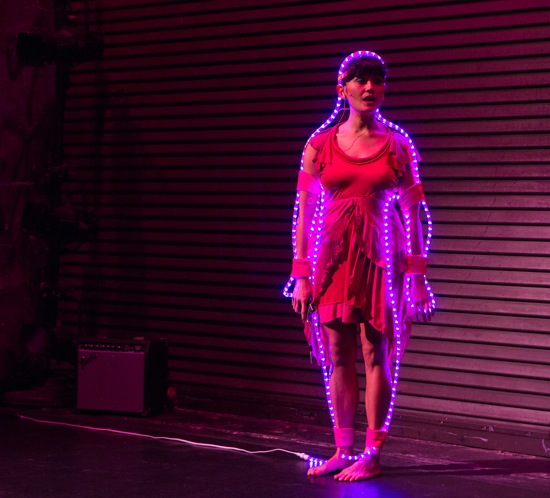
Michelle Boulé in Miguel Gutierrez’s Age & Beauty Part 2: Asian Beauty @ the Werq Meeting or The Choreographer and Her Muse or &:@&. Photo: Yi-Chun Wu
In January 12, two days after Part 1 of Age & Beauty ends its run, the devastatingly funny, sad, and nervy Part 2 opens. It has an even longer title: Age & Beauty Part 2: Asian Beauty @ the Werq Meeting or The Choreographer and Her Muse or &:@&. This world premiere weaves together the artistic and business aspects of Gutierrez’s career in ingenious ways. The spectators sit in chairs set arranged on risers on either side of the Abrons Art Center Playhouse’s stage. Each group faces a high-hung screen on which projections occasionally appear, including a live-feed image of one of the collaborators, the superb lighting designer Lenore Doxsee, who’s up in the balcony.
Onstage, we have Gutierrez; his/her muse, Michelle Boulé; his manager, Ben Pryor; and the choreographer’s surrogate, Sean Donovan. Donovan is gotten up like Gutierrez in Part 1: bleached hair and beard, pink bathing suit, and a frothy cape of white net. Gutierrez, back to his usual brunettehood, sits at pink-draped platforms bearing sound equipment, a micropohone, and an array of what look like small drum pads. He can control the sounds and recorded music and assemble them into head-banging loops (some of the music is by James Fennelly, with whom Gutierrez has collaborated before, but there are also pieces by Ryoji Ikeda, Chris Forsyth, Neal Medlyn, Gino Vanelli, Gutierrez himself, et al). He faces the performing area like a conductor, and late in the game, when Boulé is ranting ferociously, he minimally nods or shakes his head the way any sympathetic listener might do. Sometimes the only sound we hear is his intake of breath and its very slow exhalation (at least once, it took 12 seconds).
Boulé, we learn, will be performing solo material from pieces of Gutierrez’s that she has appeared in over the last 14 years. And what a muse she is! We first glimpse her in Part 2 wearing an eccentrically draped and stitched pink dress (costume creation and styling by Dusty Childers, Connor Voss, and Asta Hostetter), She is outlined in tiny pink lights (like those that defined the arena in Part 1), and she sings in a sweet, high voice words that I can’t make out. After a while, she unplugs and unfastens herself and gets ready to dance.
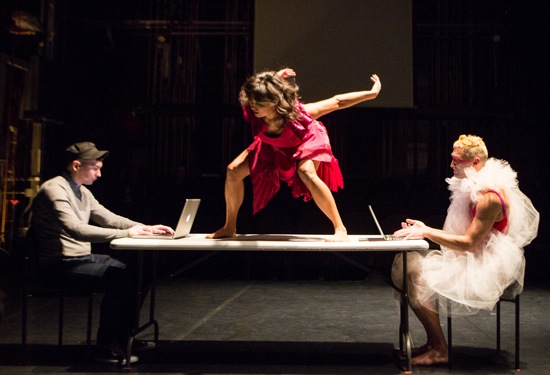
Michelle Boulé on table. Seated: Ben Pryor (L) and Sean Donovan in Gutierrez’s Age & Beauty Part 2. Photo: Yi-Chun Wu
Omigod, how she dances! She’s a one-woman storm, flinging herself recklessly around, circling a leg in the air and letting it pull her into a new direction or down to the floor. Meanwhile, early in the dance, Donovan-as-Gutierrez and Pryor (in jeans, sneakers, a sweater, and a baseball cap) sit at either end of a long table with their laptops open and discuss Gutierrez’s upcoming plans and schedule. They will do this—with variations—almost throughout the dance. Their talk is both mind-numbing and edifying. How will they procure the funding needed to finance the project that may then bring in money? How, when, and where can rehearsals begin on Part 3 of Age & Beauty? What conflicts with what? They continue hammering away, even when Boulé climbs on the table between them, places a foot on either side of Pryor’s laptop, and undulates vigorously. I particularly relish the moment when she squats and, with her butt, temporarily closes the busy little computer. The men, deep in discussion, pay scant attention—even when she starts swaying so energetically that the table sways too.
How do facts and figures enable a muse? Or is she the artful force that powers the calculations? Still, in the same way that the men argue and sigh and cross wires and stare at their screens—Pryor often trying to pin Gutierrez down—Boulé’s strength and determination are often indirect. Yes, she goes over to the proscenium arch and hits a backbend; yes, she purposefully changes her clothes. But much of the time, she lurches out of control. Donning a gold girdle of sorts and a matching blindfold, she writhes on the floor, clutching her gut, then stands and whips her torso in circles. Sometimes the lights are really bright; sometimes the stage looks bleak. The men’s verbal jousting may speed up. Donovan may wander off the immediate business at hand: “I even feel like a ghost in my own life.” Or, “Nelson Mandela died.” The men’s dialogue is so seemingly spontaneous that it’s surprising when their words appear on the suspended screens.
Text from Lauren Berlant and Lee Edelman’s Sex, or the Unbearable also figures. It has been said of the authors that “they don’t propose that sex is unbearable, only that it unleashes unbearable contradictions that we nonetheless struggle to bear.” So that figures in too.
On occasion Gutierrez functions as a stage manager. While Boulé is taking off the gold bands and temporarily exchanging the pink dress for red pants and a black t-shirt, he hangs the dress over his equipment, and the two of them chat for a few seconds and laugh together.
Sometimes it seems as if we’re in an Alice-in-Wonderland dream, where mundane facts become bizarre, and signals incite unexpected responses. The men keep re-positioning the table, and once, while Boulé is carrying on with a script and a mic, then hobbling around as if she has aged 40 years, they crouch under the table and lift it up slightly so that they can scurry, bent over, with it on their backs, like a phantom turtle setting a speed record.
The music pounds, swells, soothes, dies down. Talk of grants and budgets and schedules may stall, but it’s never-ending. And the fabulous Boulé keeps going—driving herself, turning wild, fierce, sexy—the kind of muse that doesn’t let the artist she’s inspiring sleep. Exhausted (maybe), she staggers around, muttering what sound like directions to herself. And yet, she can catch her breath and stand quietly to recite such thoughts of Gutierrez’s as “How many bad poems do I write this year?” And “All I see is winter.” And “This is the last piece I made for you.” Her speaking is followed by the re-entrance of the three men—now all (temporarily) in pink dresses and feeling perky and pretty.
In the end, the music rouses all the performers except Donovan, who’s working his laptop. As I recall, it’s Harry Wayne Casey and Richard Finch’s “Keep It Comin’ Love” that sets them rushing forward and back, but it could be Gutierrez’s own song. They’re having a party—prancing, swinging their hips around, exultant. Life is not all worrying about work, money, schedules, friends, loneliness, sex, aging, and creativity. Just now, in January, 2015, mostly so.
Gutierrez wrote the following for a duet he made in 2007. It’s called “The Problem With Dancing.” Here’s some of it:
It doesn’t sell
It doesn’t last
It doesn’t mean anything
It doesn’t translate well
It doesn’t make you rich
It doesn’t keep you warm at night
It doesn’t dance enough
It doesn’t make the ones who aren’t dancing dance. . . .?”
Guess how many of these are true. It depends. . . . Like everything else, right?

